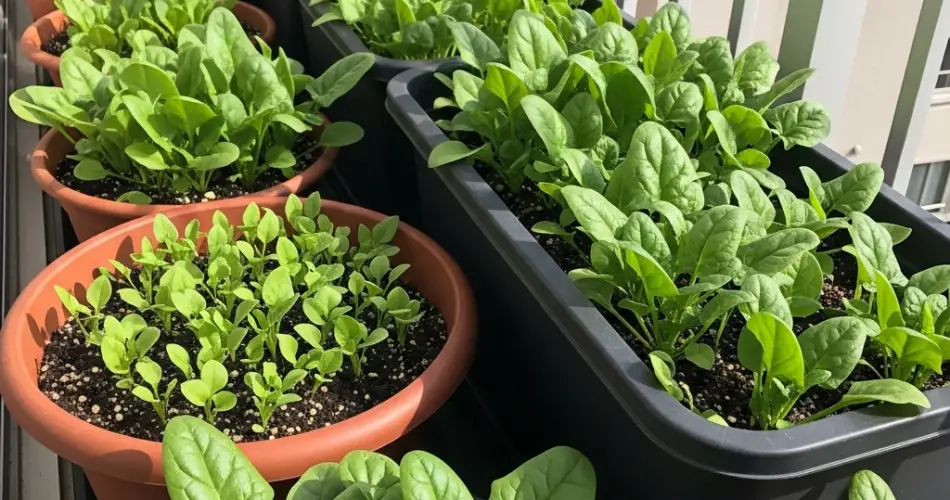If you love fresh greens but lack the space for a traditional garden, spinach is the perfect crop to grow at home in containers. It’s fast-growing, highly nutritious, and thrives even in limited spaces. With a few simple materials and a bit of care, you can enjoy fresh spinach leaves right from your balcony, kitchen windowsill, or small patio.
Spinach is rich in iron, calcium, and vitamins A and C, making it one of the most beneficial leafy greens you can add to your diet. Whether you’re a beginner or an experienced gardener, growing spinach in containers is easy, satisfying, and requires little investment.
Why Choose Containers for Growing Spinach?
Growing spinach in containers offers a range of benefits:
-
Space-efficient: Ideal for apartments, balconies, and small homes.
-
Flexible: Containers can be moved to catch the best light or avoid bad weather.
-
Clean and controlled: Soil quality, pests, and water levels are easier to manage.
-
Low-maintenance: Minimal weeding and no heavy digging.
-
Year-round potential: With the right conditions, spinach can grow across multiple seasons.
Even if you’re short on time or space, container spinach growing is a simple way to bring fresh produce into your home.
Materials You’ll Need
To get started, you’ll need:
-
A container (6–8 inches deep) with drainage holes
-
Potting mix or a blend of compost, garden soil, and coco peat
-
Spinach seeds or seedlings
-
A watering can or spray bottle
-
A sunny location (4–6 hours of light per day)
Optional materials:
-
Mulch (e.g., dried leaves or coco husk)
-
Organic liquid fertilizer or compost tea
You can use traditional pots, grow bags, buckets, or even recycled containers like old tubs or plastic bottles. Just make sure they have good drainage.
Step 1: Prepare Your Container
Choose a wide, shallow container—spinach has shallow roots and spreads out more than it grows down. Ensure the pot has holes at the bottom to allow excess water to drain.
Fill the container with a nutrient-rich potting mix. A good blend is one part compost, one part garden soil, and one part coco peat or sand for aeration. Leave about an inch of space from the top for easy watering.
Step 2: Plant the Spinach Seeds
Sow your spinach seeds about ½ inch deep and 2 inches apart. If using seedlings, plant them 3–4 inches apart to give each plant enough room to grow.
After sowing, lightly cover the seeds with soil and water gently. Use a fine spray or a watering can with a narrow spout to avoid washing the seeds away.
Place the container in a spot that receives at least 4 to 6 hours of sunlight daily. If you’re growing indoors, a sunny windowsill or a spot under grow lights will work well.
Step 3: Watering and Sunlight
Keep the soil moist but not soggy. Spinach likes consistent watering, especially during warm or dry conditions. Check the soil daily—if the top inch feels dry, it’s time to water.
Make sure your container gets good sunlight, especially in cooler weather. In hot climates, offer some afternoon shade to prevent bolting, which causes the plant to flower early and become bitter.
Step 4: Feeding and Mulching
If your soil mix is rich in compost, additional feeding may not be necessary. However, for stronger growth, feed your spinach with a diluted organic fertilizer or compost tea every 2–3 weeks.
Adding mulch around your spinach plants helps retain moisture, suppress weeds, and keep the soil temperature stable.
Step 5: Harvesting Spinach
Spinach is usually ready to harvest within 4–6 weeks of planting. You can begin cutting leaves when they are about 3–4 inches long.
For ongoing harvests, use the “cut-and-come-again” method: snip the outer leaves first and allow the center to keep growing. If you prefer a full harvest, cut the entire plant just above the soil line once it matures. In cooler conditions, it may regrow after full cutting.
Harvest in the early morning when the leaves are crisp and full of moisture.
Step 6: Replanting for Continuous Greens
Spinach grows quickly, so you can stagger your plantings every two weeks for a continuous supply of fresh leaves. After each harvest, refresh the soil with compost and replant new seeds.
This cycle keeps your containers productive and ensures a regular harvest throughout the season.
Tips for Growing Spinach Successfully
-
Use fresh seeds for better germination rates.
-
Thin seedlings to reduce crowding and improve airflow.
-
Avoid letting the soil dry out, especially in warm weather.
-
Harvest often to encourage new growth.
-
Protect from pests such as aphids using neem spray or gentle soapy water.
Final Thoughts
Growing spinach in containers is a practical, affordable, and enjoyable way to bring fresh, healthy greens into your daily meals. Whether you live in a small apartment or have limited time, container spinach gardening allows you to stay connected with nature and improve your diet without much effort.
With the right setup and a bit of attention, your spinach plants will thrive and provide you with delicious, homegrown leaves anytime you need them. It’s a perfect first step into growing your own food—right from a windowsill or balcony.



